The Shoe Shop art and walking festival, presented by the Goethe-Institut, 2-31 May 2012, Johannesburg.
MATTHEW WILHELM-SOLOMON
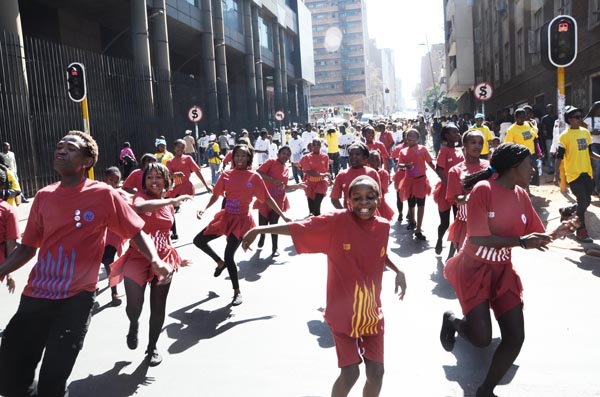
The Shoe Shop Parade, led by the Alexandra Field Band, moves through inner-city Johannesburg 01
The Shoe Shop festival, based in the shell of an old bakery in Braamfontein, was an exploration of walking, of movement and migration extending throughout Johannesburg during the month of May.
The event, organised by the Goethe-Institut and curated by Cara Snyman and Marie-Hélène Gutberlet, and including primarily African artists, has involved a parade, a series of themed walks, screenings of films at the
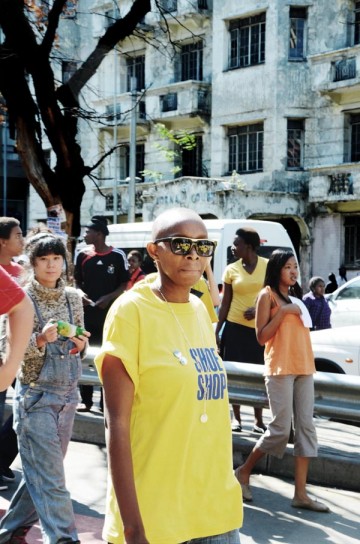
The Shoe Shop parade passes a derelict building opposite Joubert Park
Bioscope,along with photographic posters that the public can curate themselves in the city.
The first walk was guided by Doung Anwar Jahangeer, an architect from Durban. Jahangeer, an animated speaker, called for attention to “in-between spaces”: the stories written in garbage; the varieties of grass on the paving; the traffic island outside Hillbrow police station sheltering tired mothers; God’s cellphone number scrawled on an alley way wall.
On this walk through Hillbrow, as we passed a long white limousine parked beside a rundown tenement, I met filmmaker Idrissou Mora-Kpai.
Mora-Kpai’s contribution to the festival – Indochina, Traces of a Mother – captures many of the themes of the festival. It tells the neglected story of West African soldiers who fought for France against the Viet Minh and who had families with Vietnamese women. When the French pulled out of the war, the children were torn away from their mothers and sent back to Africa with the repatriated soldiers.
In a moving scene a man from Benin returning to Hanoi, searching and failing to find any trace of his mother, scatters the ashes of his older sister into the Mekong River – her final wish was to be closer to her mother and to be interred in the waters of a country she had left a child. It is a startling film.
Mora-Kpai’s own story is a journey from rural Benin through Niger and North Africa to eventually studying film and setting up a production company in Berlin.
He reflected to me: “All of us have melancholy in our lives. We have to reflect on what is our home. Is the USA my home, is Germany my home, is Benin my home? Even when I am back, home is not the home I knew before. All that is left behind you get from fantasy, because it doesn’t exist anymore.”
Nigerian filmmaker and fashion magazine editor Andy Amadi Okoroafor’s screening probes similar themes to Indochina, though in a contrasting style. His film Relentless is high melodrama, drawing on motifs from Nigerian soap operas and Nollywood: corrupt politicians in long robes, ritual sacrifice, machete murders.
The backdrop is the Nigerian involvement in the Sierra Leonean and Liberian wars and it too provides a stark account of the dislocations of violence and a yearning for a home that is unreachable or erased.
Beneath the action, the film provides a remarkable portrait of Lagos through images of still evening highways contrasting with the day’s traffic, and the swelling of the ocean against a beach soaked with booze and desire.
The selection of films in the festival – with their many interconnected paths – was exceptional, though the screenings, including those with the directors in attendance, were often poorly attended. Hopefully the festival will inspire repeat showings; the encounter with filmmakers from elsewhere in Africa could certainly enrich our local productions.
The photographic side of the exhibition allows anyone to collect a few posters from a wide selection at the Shop – by photographers including Thabiso Sekgala, Emmanuel Bakary Daou and Jürgen Schadeberg among others – to place around the city.
In Raleigh Street, Yeoville, Fatoumata Diabaté’s stark black and white images of migrants in Auberville, Paris, are pasted on the side of an old train. Formerly an up-market restaurant, the train’s entrance is now blockaded with barbed wire, its windows smashed.
A man selling gospel CDs beside the train commented on the images: “I don’t know what they are for.”
This raises the perplexities of taking exhibitions out of the gallery – their aesthetics may be irrelevant to the tastes and functionality of the street; images are easily erased and effaced.
Pasted over Diabate’s image of a man in a Paris telephone booth is an advert by a Professor Banda offering to return lost lovers in two days.
I wondered if there was a connection in spirit between the man in the booth – perhaps calling family in a distant city – and those who will call Professor Banda to try cure their heartache.
The walks raised similar questions around aesthetics and public space.
Donna Kukama, a soundscape artist, led her own walk focusing on the relationship between sound and territory, pronouncing that “this is not a tour”.
Little was said as we trekked through Small Street Mall, past a transsexual dancer in leopard skin tights and veldskoene, inviting us in to buy sportswear. Outside another store a man was ringing a bell like some Catholic altar boy, pin-pricking the avalanche of hip hop.
When Bettina Malcomess set up her shoe-shining stall on the pavement, a roving installation,
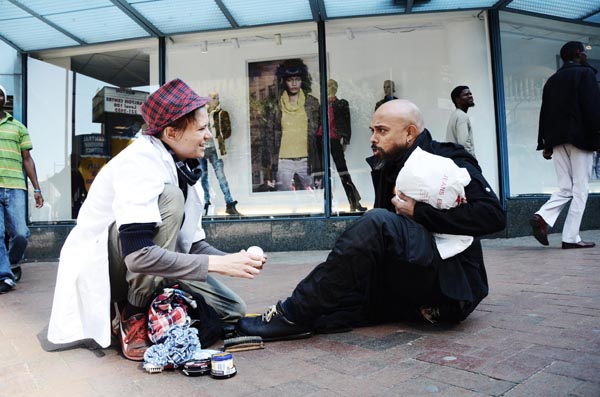
Artist Bettina Malcomess shines Doung Anwar Jahangeer's shoes outside the Small Street Mall
we were twice removed by security and municipal guards who demanded to know what we were doing there.
This event resonated with a recurring feature of the migrant experience of Johannesburg: the constant harassment by private and public security.
The festival was launched with a joyous march from Braamfontein through the early winter sun and led by the
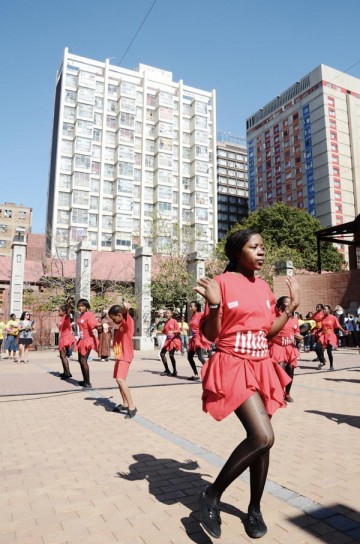
Dancers perform with the Alexandra Field Band at the Drill Hall in inner-city Johannesburg
excellent Alexandra Field Band to the Drill Hall, where the crowd was greeted with DJs, musicians and food.
As the marchers sat inside the open square of the Drill Hall, eating the braaied food on offer, a group of Zionist Church members in white robes and blue sashes sat in the shade of the trees watching the gathering through the fence. Eventually they joined in the food line but then returned to their spot outside.
I wondered: was it simply that they preferred the shade of the trees to the open square, or was it something else – that in this city we have internalised our enclaves so deeply that even when gates are open they remain closed in our minds?
A lasting impression of this uneasy yet inspiring festival, is that if walking and movement are an emblem for modern freedom, then they also have an under-sole.
Penny Siopis’ short montage film Obscure White Messenger recalls the story of Demetrios Tsafendas, a stateless man born in Mozambique who lived most of his adult life working at sea, and came to South Africa in search of his mother. The journey ends when, out of madness or anger at the racist regime, he murders apartheid father Hendrik Verwoerd, and ends up in an asylum.
Angelika Levi’s Absent Present follows a Namibian boy named Benji who was given refuge in the German Democratic Republic during the Namibian war and then abruptly sent back to the Namibian conflict when the Berlin Wall fell. In his late adolescence, Benji made his way up through Africa and back to Germany only to end up stateless: he disappears without a trace before the film is completed.
The stories of these films cross one another like ships in the night. The sense that lingers is that journeying in search of escape or home too often ends in violence and entrapment – or merely absence.
Visit the Shoe Shop Project's web page.
Matthew Wilhelm-Solomon is a researcher at the African Centre for Migration & Society.
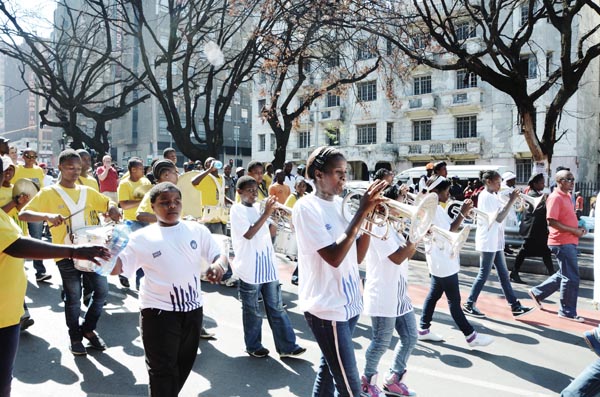
The Shoe Shop Parade, led by the Alexandra Field Band, moves through inner-city Johannesburg
 SLiPStellenbosch Literary Project
SLiPStellenbosch Literary Project